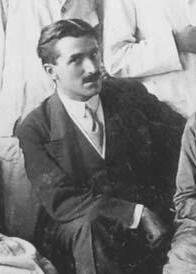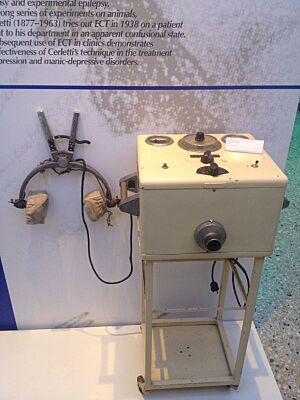Ugo Cerletti facts for kids
Quick facts for kids
Ugo Cerletti
|
|
|---|---|

Cerletti in 1909 or 1910
|
|
| Born | September 26, 1877 Conegliano, Kingdom of Italy
|
| Died | July 25, 1963 (aged 85) Rome, Italy
|
| Nationality | Italian |
| Known for |
Inventing electroconvulsive therapy
|
| Scientific career | |
| Fields | Neurology, neuropsychiatry, Psychiatry |
| Institutions |
|
Ugo Cerletti (born September 26, 1877 – died July 25, 1963) was an Italian doctor who studied the brain and nervous system. He is famous for discovering a treatment called electroconvulsive therapy (ECT). This therapy uses a small electric current to cause a brief seizure in the brain. Doctors use ECT to help people with certain serious mental health conditions, especially when other treatments haven't worked.
Contents
Life and Education
Ugo Cerletti was born in Conegliano, Italy, on September 26, 1877. He studied Medicine in Rome and Turin. Later, he chose to specialize in studying the brain and nervous system. This field is known as neurology and neuropsychiatry.
Early Studies and Research
In his early scientific work, Cerletti focused on how nervous tissue reacts to different problems. He showed that nervous tissue responds in its own special ways. This helped make the study of nervous tissue a separate and important part of medicine.
As a student, he learned from many important doctors of his time. He studied in Paris, France, with Pierre Marie. He also learned in Munich, Germany, with Emil Kraepelin, who is called the "father" of modern psychiatry. He also studied with Alois Alzheimer, who discovered the most common type of dementia.
Career and Discoveries
After his studies, Cerletti became the head of the Neurobiological Institute in Milan. He led the psychiatric hospital in Mombello, Milan, from 1919 to 1924. In 1924, he started teaching Neuropsychiatry in Bari.
Later, in 1928, he became a professor at the University of Genoa. Finally, in 1935, he moved to the University of Rome La Sapienza. There, he became the head of the Department of Mental and Neurological Diseases. It was in Rome that he developed electroconvulsive therapy (ECT). This discovery made him famous around the world.
Developing Electroconvulsive Therapy (ECT)
The idea for using ECT in people came to Cerletti in an unusual way. He saw pigs being made unconscious with electric shocks before they were prepared for meat. Cerletti wondered if electric shock could also help people with mental health conditions.
Previous Treatments and Ideas
Before Cerletti's work, other treatments were used for mental health issues. Since 1935, a drug called metrazol and a hormone called insulin were used. These were given to cause seizures or comas in people with schizophrenia. This idea came from earlier research by Julius Wagner-Jauregg. He used malaria to cause seizures to treat some nervous disorders. Another doctor, Ladislas J. Meduna, believed that epilepsy and schizophrenia were opposites. His drug-induced seizure treatment was later mostly replaced by Cerletti's electrical method.
Experiments and First Use
Cerletti began by doing many experiments with animals. He used electric currents to cause seizures in dogs and other animals. In his early tests, some animals did not survive. In Rome, his assistant Lucio Bini helped create a safe machine. This machine had a control panel that could be used on humans.
Cerletti first used ECT on a human patient in April 1938. The patient had schizophrenia with confusing thoughts and hallucinations. After a series of electric shocks, the patient's mind returned to a more normal state. This showed that electric shock treatment could help people with specific conditions.
ECT quickly became a popular treatment. Cerletti and his team did thousands of electroshocks on animals and patients. They found that ECT was useful and safe for conditions like severe depression and manic-depressive illness. His work spread quickly, and ECT became a worldwide treatment. Cerletti was known for making sure patients did not feel discomfort during the treatment.
Cerletti's Theory and Legacy
Cerletti believed that ECT made the brain produce special "vitalizing substances." He called these "agro-agonines." He even tried injecting patients with a liquid made from the brains of pigs that had received electroshock. This "electroshocked pig brain therapy" was used by a few doctors. However, it did not become as popular as ECT itself. ECT became widely used because it was cheaper and easier than other shock treatments.
Cerletti and Bini were even nominated for a Nobel Prize for their work on this treatment. Today, ECT is often used for severe depression that has not improved with other treatments. It is also sometimes used for mania and catatonia (a state where a person does not move or respond).
Other Contributions
Ugo Cerletti was active as a doctor for a long time. He published many scientific papers. These papers were about topics like Alzheimer's disease and the blood–brain barrier. In 1950, he received an honorary degree from the University of Paris. He also received many other awards.
Beyond his medical work, Cerletti had other interesting ideas. He suggested using white uniforms for soldiers in the mountains during the First World War. This would help them blend in and be harder to see. He also invented special artillery missiles. These missiles had delayed-action fuses. They were used by the Italian and French armies to create minefields.
Ugo Cerletti passed away in Rome on July 25, 1963.
See also
 In Spanish: Ugo Cerletti para niños
In Spanish: Ugo Cerletti para niños


